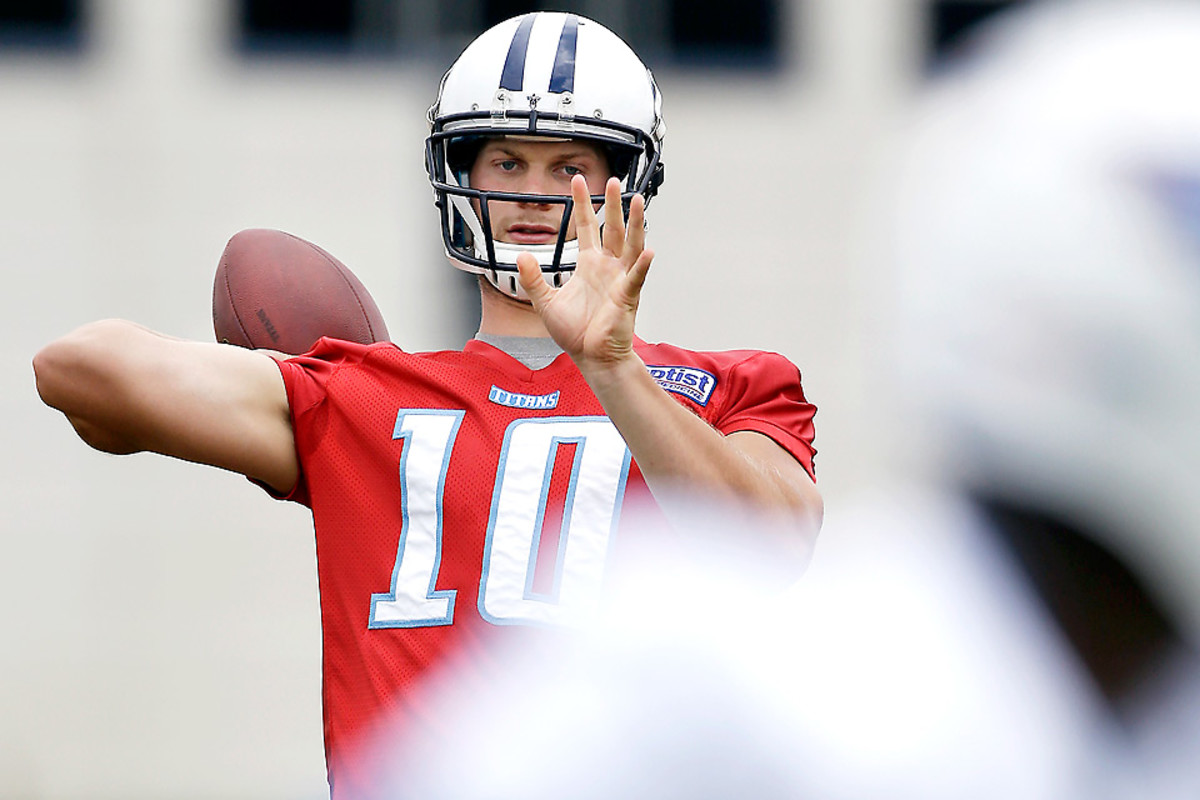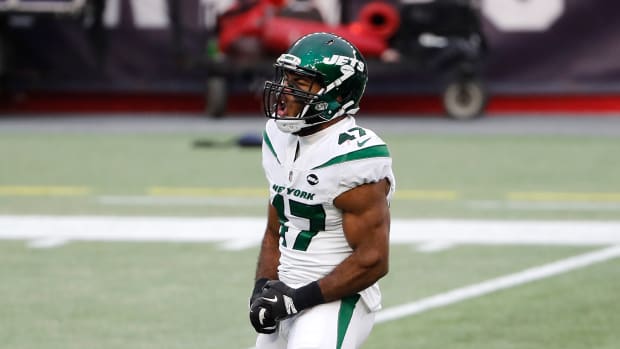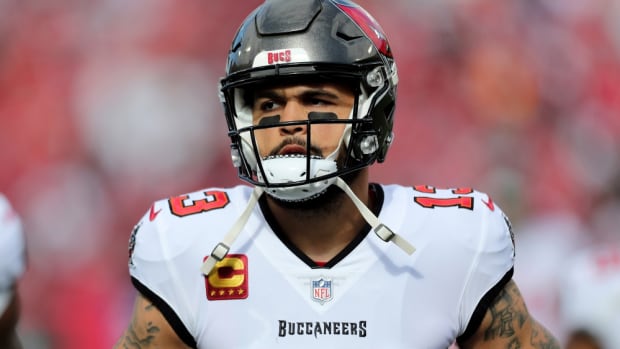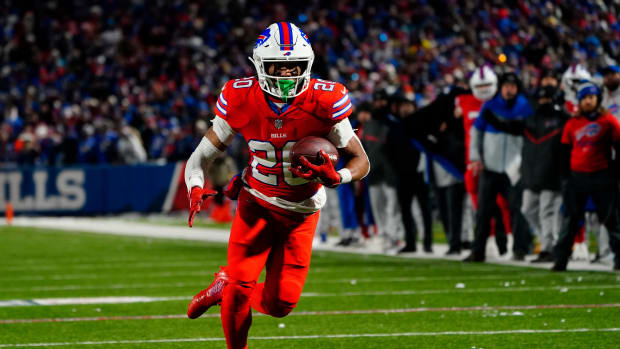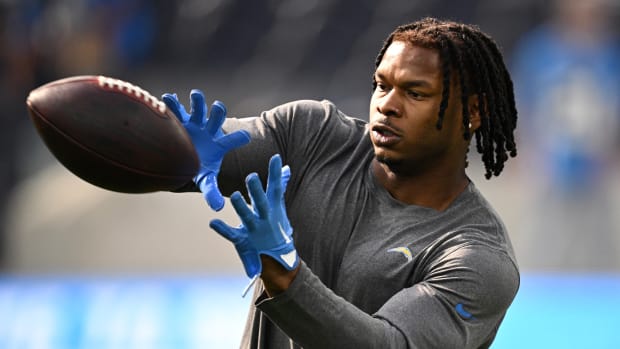Titans Preview: Stuck in the Middle With You
The Titans are football’s version of a Wednesday afternoon: not enthralling, not depressing, just sort of there in the middle. Unless you’re from the Volunteer State, you probably don’t think about the Titans. If prompted, you might acknowledge them as a solid organization, but seeing how it’s never surprising when they win and never surprising when they lose, there’s not a whole lot to chatter about.
It can be difficult for a team to get off this middle path. When things are going well, you’re just good enough to believe in your modus operandi. When things are going poorly, you’re not quite bad enough to force an overhaul. It’s not surprising that after Bud Adams fired 17-year head coach Jeff Fisher in 2010, the then-88-year-old owner filled the vacancy from within, promoting offensive line coach Mike Munchak. Adams took this same approach in his front office last offseason, firing top executive Mike Reinfeldt and moving No. 2 man Ruston Webster up the ladder. And he signed off on another internal change in the middle of last season, when offensive coordinator Chris Palmer was replaced by quarterback coach Dowell Loggains.
For all their in-house moves, the Titans are not totally averse to drastic change. Three years ago they used the eighth overall pick on Jake Locker, a somewhat unconventional, mobility-based quarterback around whom they would have to redesign their offense. But after sitting behind Matt Hasselbeck (the epitome of conventional) in 2011 and missing five games with a shoulder injury last season, Locker has yet to make much of a mark. Building around him would be a gamble at this point, as Tennessee’s roster enters 2013 with no glaring weak spots. This is a team built for the present. The ceiling may not be spectacularly high, but with stability at quarterback neither would the floor be too low.
Hasselbeck is gone, replaced by Ryan Fitzpatrick, another experienced starter capable of leading a solid team to at least a safe 8-8. Going .500 isn’t what the NFL is about, though. Which is why the Titans are prepared to take the risks that come with Locker. Slim as it might be, that’s their only real chance at excellence. But will this team’s brass have the gall to fully commit?
OFFENSE
It’s easy to say Munchak and Loggains should just go all-in and build an offense around their third-year quarterback. The reality is, working for an impatient owner who has never hesitated to put public pressure on his employees, Titans coaches are forced to take the short term into heavy consideration.
Going all-in on Locker would mean reshaping a traditional dropback offense around more mobile quarterbacking concepts, like rollouts and bootlegs and perhaps even the read-option. Munchak has said the Titans will cater more to Locker’s skills in 2013. But to what degree?
Hanging too much on the unripe 25-year-old could make for some serious growing pains. Besides, no matter how athletically gifted a quarterback might be (Locker is above average but no RG3), he can’t succeed in the NFL without at least respectable dropback skills. This is where Locker is lacking. His footwork and release mechanics still need work. He does not consistently read defenses or anticipate routes. His pre-snap awareness is primitive at times (a great example was the play on which he hurt his shoulder last year—see the graphic below). Locker has shown glimmers of potential in all of these areas, but precious little development.
Loggains will have to install a system that plays to Locker’s strengths while giving him opportunities to fix his weaknesses. In four games last season, Locker failed to complete more than 50% of his pass attempts. If he endures such difficulties again this year, Loggains may be tempted to go with Fitzpatrick, who is essentially a less physically gifted but more experienced version of Locker.
Loggains has said he plans to lean on the run game more in 2013. That’s wise, but there’s work to be done there as well. Rushing for 2,006 yards in 2009 was the best and worst thing that ever happened to Chris Johnson. The best in that it put him on the map; the worst in that it made him an undisciplined back who is obsessed with trying to break long runs. Johnson has averaged 1,218 yards per season and a full yard less per carry in the three years since he became CJ2K. Those aren’t bad numbers, but the Titans’ run game as a whole has ranked just 21st, 31st and 17th over the last three years. Johnson’s lack of physicality and poor discipline have deprived Tennessee of an inside ground attack. That has hurt in obvious running situations. Instead of hoping their soon-to-be 28-year-old star will change, the Titans signed Shonn Greene to be their new power runner. Greene was a disappointment as a starter with the Jets last season, but in previous years he has been a tremendous downhill thumper off the bench. When fresh-legged, he’s particularly good on outside tosses, which feature prominently in Tennessee’s zone-blocking concepts.
Johnson, who publicly expressed his chagrin at Greene’s arrival, has campaigned for better run-blocking, which makes sense, as a finesse runner is inherently more dependent on having paths cleared for him. Johnson’s wish was granted; Tennessee signed left guard Andy Levitre in free agency and used the 10th overall pick on massive right guard Chance Warmack. If veteran tackle David Stewart can come back from a broken right leg suffered last December, he and Warmack will form one of the most effective road-grading right side tandems in the league. If Stewart isn’t the same, less forceful sixth-year pro Mike Otto has at least proven capable as a starter.
On the left side, Levitre did not come cheap (six years, $46.8 million, though only about a quarter of it guaranteed), but he brings a strong combination of mobility and power in run-blocking. He’ll play alongside one of the league’s steadiest left tackles in long-armed veteran Michael Roos (who, granted, was uncharacteristically vulnerable in pass protection a few times last year). At center, the Titans may feature another 310-plus-pound rookie if fourth-rounder Brian Schwenke can beat out incumbent Fernando Velasco for the starting job.
While the Titans still carry a fullback (Quinn Johnson, who has good size but unexceptional range), they could try to reinforce their run-blocking with more dual tight end designs in 2013. In Delanie Walker they signed one of the league’s smartest and most versatile move-blockers and intermediate receivers. The ex-Niner is an upgrade over the more athletic but pricier Jared Cook. Serving as the second tight end will be short-area receiver and sound blocker Craig Stevens, though there’s an outside chance that last year’s uncultivated but insanely athletic fifth-round pick Taylor Thompson will push for more reps.
With 2009 first-round pick Kenny Britt dealing with a “brittle” knee, the Titans have felt compelled to draft a wide receiver early each of the last two years. In 2012 they chose Kendall Wright, who runs well and has good command in and out of his breaks. (That needs to translate to more production this season; the 9.8 yards per catch Wright averaged as a rookie are not enough for someone with aspirations to be more than just a slot weapon.) In 2013, they’ve added Justin Hunter, whom some have described as the most talented wideout in the draft. Hunter is extremely green, however. He’ll spend his rookie year learning behind dependable veteran Nate Washington and likely competing with possession targets Damian Williams and Kevin Walter for No. 4 duties (assuming Britt can be one of the top three receivers).
DEFENSE
For much of last season, defensive coordinator Jerry Gray was convinced that his unit was good enough to simply line up and play vanilla 4-3 zone concepts. It wasn’t. An unaware linebacking corps, an overly conservative group of cornerbacks, an overly aggressive free safety and a team-wide penchant for missing tackles (particularly in the open field) led to Tennessee’s allowing an AFC-worst 421 yards per game through the first eight weeks. The Titans’ bland, ultra-deep two-high zone looks made them the easiest defense in pro football to prepare for and execute against.
When injuries dinged the front seven midseason, Gray felt the Titans could no longer generate consistent pressure with a straight four-man rush. So, he instituted more blitzes, which led to more disguises, which led to more revolving coverage looks. The Titans were noticeably more competitive in these situations, allowing an average of just 299 yards for the first six games of the season’s second half.
Gray seems poised to stick with more diverse concepts in 2013. He has an unconventional attack-minded new assistant on staff in long-time friend Gregg Williams, and there has been a lot of chatter about more man coverage. But change can be easy to promise and hard to deliver. Gray is a longtime two-deep zone subscriber. And he has a front four that he could reason is capable of generating its own pressure. Left defensive end Derrick Morgan has blossomed into an outstanding all-around player. Morgan’s first step off the edge isn’t scintillating, but his second and third steps are very effective. He’s very good at redirecting inside and sliding laterally (which makes him strong against the run). At right end, Kamerion Wimbley is not a first-rate burner, but he’s nimble enough to skim the corner. Having gotten between six and nine sacks each of the last four years, Wimbley doesn’t command many double teams, which might be why the Titans used a fifth-round pick on Lavar Edwards, a swing end at LSU who could perhaps develop into a competent sub-package pass rusher. They also signed massive former 3-4 end Ropati Pitoitua, who will vie for rotational snaps on run downs.
Inside, 2012 third-round pick Mike Martin is quietly developing into a fine one- and three-technique force. He has even cut into interior pass-rush specialist Karl Klug’s playing time thanks to his effectiveness in nickel and dime fronts. (Klug will get chances at defensive end now.) Starting alongside Martin is the third-round pick from a year earlier, Jurrell Casey, who has excellent initial quickness for a 300-pounder. With Sen’Derrick Marks not being retained, the primary backup tackle will be ex-Lion Sammie Lee Hill, who can play on any of the three downs.
If Gray goes with a static 4-3 defense, opposing offenses will have no trouble figuring out run-blocking assignments against this front. Consequently, Tennessee’s linebackers will have to play extremely fast. Weakside man Zach Brown is capable of doing this physically—he set school track records at North Carolina and smoothly transfers his 4.37 speed to the field—and as a second-round rookie last year he showed marked improvements each week in his grasp of the position. If he can maintain his ascension, he’ll be a star. On the strong side, linebacker Akeem Ayers is very comfortable in a stack position, often serving as a de facto fifth defensive lineman against the run. Ayers also has good speed off the edge, as evidenced by his six sacks as a situational rusher last year.
In the middle, Colin McCarthy is looking to play better after an injury-filled 2012 season. The third-year pro has flashed good recognition skills as a downhill player; his next step is finding more consistency. Interestingly, the Titans did not add significant depth at linebacker (unless you count finesse veteran Moise Fokou), but they spent a late third-round pick on run-and-chase outside guy Zaviar Gooden.
They also had an early third-round pick, which they used on cornerback Blidi Wreh-Wilson, who many analysts believe has the size and skills to eventually start. That would allow solid tackler Alterraun Verner to slide back into his more-fitting nickel slot role. That spot was occupied last year by Coty Sensabaugh, who experienced a few bumps in man coverage. The No. 1 corner will still be Jason McCourty, who is solid in a zone scheme but not worth the $17 million that was guaranteed in his long-term contract last year.
Whether Gray keeps this secondary in two-high zone looks or sprinkles in more man concepts, the defense won’t flourish until its safeties perform better—most notably Michael Griffin, who has Pro Bowl-caliber range and ball skills but has taken far too many bad angles in coverage the past two seasons. Missed tackles have also been a problem. At strong safety, veteran pickup Bernard Pollard will provide some much-needed pop as a box defender. Also, mutli-tooled ex-Bill George Wilson is in the picture. He’s not a playmaker, but he has always had a natural feel for being around the ball.
SPECIAL TEAMS
Powerful kicker Rob Bironas uncharacteristically missed five of his 10 tries from 40 to 49 yards last season. Consider it a fluke; Bironas was 53 of 58 on all field goal attempts over the previous two years. Punter Brett Kern has ranked 13th or 14th in net average three of the last four years. In the return game, once-budding star Marc Mariani is hoping to find his old form after suffering a gruesome broken leg last August. Even if he does, there’s a chance he may not reclaim his spot, as Darius Reynaud scored on two punts plus a kick return filling in last season.
Outlook
This team is solid just about everywhere except quarterback. It’s unlikely they’ll get a standout performance from Locker, which means the question is whether the revamped offensive line and backfield can forge a running game vigorous enough to carry the load. If they can, the improving young defense will still have to take two steps forward to make the Titans a playoff team.
Andy Benoit is diving deep into each team’s prospects for 2013. Read what he’s done so far.
































